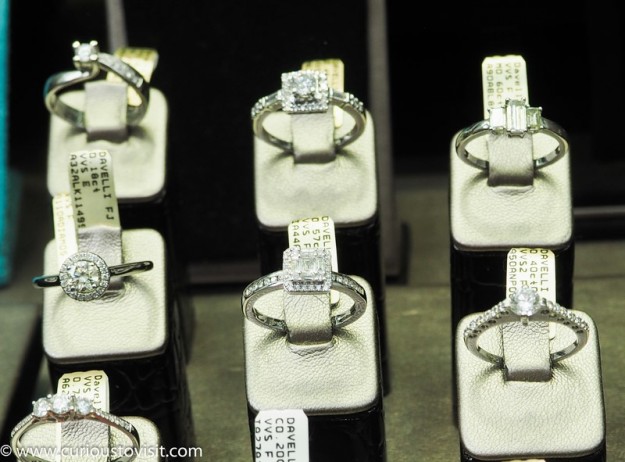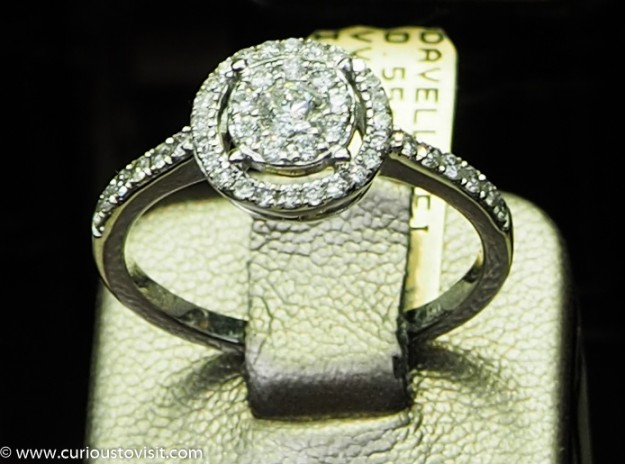
Diamond might sound like an odd topic for a travel blog, but my recent trip to Antwerp in Belgium reminded me that people do make some significant purchases on their trips and for some, a significant purchase is the main reason why they end up in a foreign country in the first place.
DISCLAIMER: I am a lay person and have no association with diamond industry whatsoever. This blog post is an outline of things that I personally learnt from talking to diamond dealers in Antwerp, Belgium, and my impressions from watching a friend go through the buying process. This text does not constitute official guidelines of how to buy a gemstone. Always seek expert opinion when making such purchases.
A friend of mine decided she wanted to get a first-ever diamond ring for herself and invited me to come along ‘for support and courage’ to Antwerp, considered one of the most important trading places for diamonds.
I accompanied her without any previous knowledge of this industry, trade and the intricacies of buying a gemstone.
My friend, on the other hand, knew something vague about 4 Cs, had a little cash to spare and a huge desire to own a diamond ring.
So, armed with virtual ignorance and a desire for a sparkly gemstone, we hit the famed diamond district….
Several shops, a few extensive conversations with dealers and one diamond ring later, here are 10 important lessons learnt.
- Do your homework.
Don’t be like us, make sure you read up on terminology and know what it means BEFORE you enter any jewellery shop.
It’s not rocket science and can save you lots of money in the long run, especially when some dishonest dealer tries to take advantage of your ignorance (which will happen!).
- Beware of unscrupulous dealers.
Some of them try to rush you into buying decision, acting offended that you came in just to enquire and not make a deal there and then and ‘waste their time’. They will also use a lot of jargon without explaining what it means.
Reputable dealers seem to try and educate the customer first and prefer to sell to people who understand what it is that they are buying.
For example, the dealer my friend eventually bought a ring from, first gave us about 1 hour of his time educating us about the gemstone, its value and specs before he started pushing for a sale.
- Take it very slowly (see point 2 above).
Do not rush, understand before taking a decision.
Some dealers try to create the impression that they are extremely busy or laugh into your face if you say something not very clever (it happened to us!).
Don’t get intimidated or embarrassed, take your time, after all, it’s your money!
- Always haggle.
It was surprising to see that, unlike in the UK, there don’t seem to be any prices displayed in shop windows.
Prices of gemstones in Antwerp seem to be negotiable, especially in smaller shops.
So think of this place more as a marketplace, where it would be unwise to pay the price the dealer is asking for. My friend, for example, got a €200 cheaper price than initially asked for.
- Ask for the gemstone grading report.
One dealer told us that a ‘certificate’ or appraisal from a shop (no matter how prestigious the brand) does not really carry any weight when it comes to the value of the stone.
Only a grading report from a reputable lab is a valuable document if you want to be sure you are buying the real thing.
GIA (Gemological Institute of America) grading report seems to be the preferred one since their criteria are the most rigorous.
- Be clear whether you want a natural diamond or one with artificial enhancements.
There seems to be a bit of tension in the gemstone community between dealers who sell only natural diamonds and those who sell something that is called (in layman’s terms) clarity enhanced diamonds or php diamonds (technical term) i.e. diamonds with artificial improvements of its appearance.
Apparently, dealers are supposed to inform the client about the fact that the gemstone clarity is enhanced, but often fail to do so, thus causing some people to buy inferior quality gemstones without knowing it.
Always ask if the diamond is natural.
If it comes with a grading report, that report should indicate whether its clarity has been enhanced or not.
- Know what is most valuable 1.
The price of the piece of jewellery (in this case a ring) mainly seems to depend on the specifications of the main diamond, which in Antwerp is often sold separately, i.e. you first choose a stone and then choose a style of a ring.
- Know what is most valuable 2.
If you are looking for a piece of jewellery with a number of tiny diamonds and no bigger gemstone, keep in mind that what you are really paying for, is the work and craftsmanship that went into setting the stones and not so much for the stones themselves.
The collective value of small diamonds seems to be much lower than that of one larger stone.
- Be careful if buying flawless.
For those who plan to spend some serious cash on a diamond by buying a flawless stone, it is important to remember that flawless ones are very rare to come by.
Besides, now there are a lot of artificial versions which are, apparently, almost impossible to tell apart from the real ones.
One dealer told us, when buying a diamond, she would not go higher than VVS clarity category since imperfections indicate that the gemstone is natural.
- No two diamonds are alike.
The dealer my friend eventually bought from explained to us that the price of a diamond depends on a number of different factors, i.e. the four C’s (carat, clarity, colour and cut) as well as fluorescence, polish, symmetry and clarity characteristics.
And as no two stones are exactly the same, there can be significant variations in price between stones which, to a lay person, might look alike.
On a final note….
After coming back to England, armed with all the newly gained knowledge, I thought I’d do a bit of research on my own and see how prices compare as well as how dealers here try to sell diamond jewellery.
Well, one thing is certain, the shop assistants I spoke to in a number of different shops, did not seem to know half of what I knew….
Their main selling point was the ‘sparkle effect’, i.e. a number of them told me ‘look how beautifully it sparkles on your finger!’…. Really….?
I might as well go and buy something from Swarovski then – so much cheaper!
One stark difference I noticed in the way shops mark the specifications of the stone is that here in the UK, if a ring has one larger and a few smaller diamonds, the shop marks a grand total carat weight on the label, thus creating an impression that the main diamond is larger.
Also, while they provide grading reports, it is not very clear whether the report describes the main stone or all of them. And if, as we learnt, no two diamonds are the same, how can there be just one report on a number of stones?
Here’s an excellent website, educating consumers about all aspects of diamond qualities.
So next time you are in Antwerp – go shopping in diamond district….




 Hi, I am Vytenė, a travel blogger originally from Lithuania. Highlighting here European destinations worth exploring. You don’t have to go far to have the time of your life!
Hi, I am Vytenė, a travel blogger originally from Lithuania. Highlighting here European destinations worth exploring. You don’t have to go far to have the time of your life!
